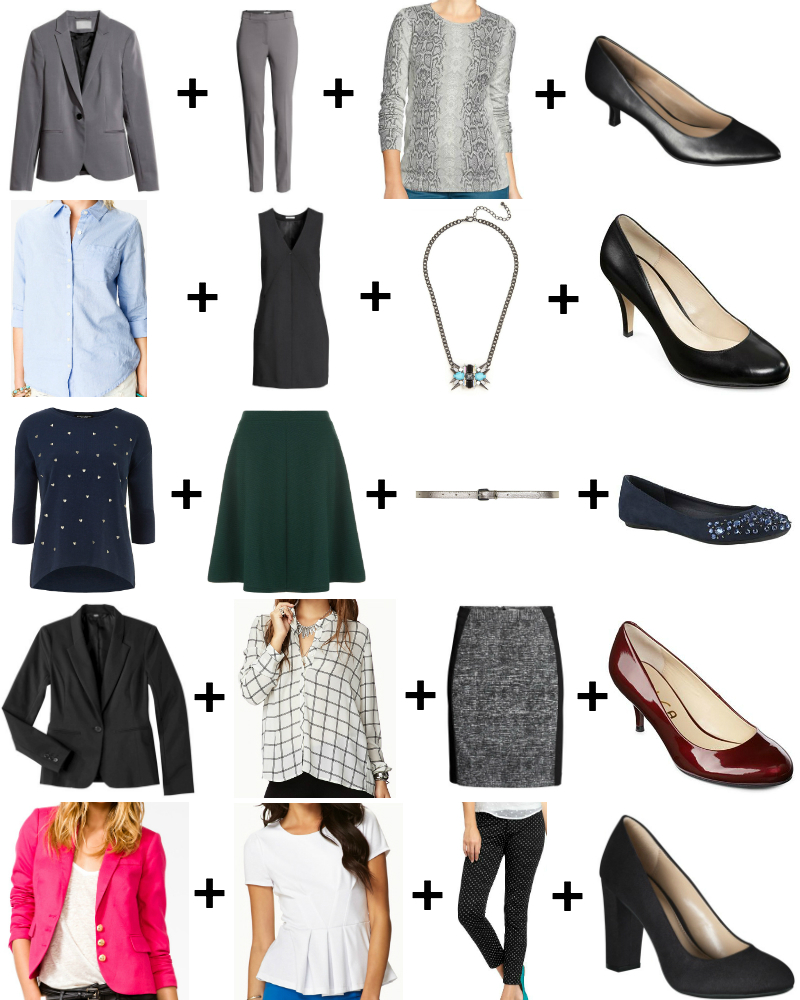Dress codes are so easy for men. Whether it’s a suit, a sport coat, a tie or jeans, it’s always spelled out for them.
That’s not to say that men always dress appropriately for work. I’m not sure which is worse: The fact that the coordinator for my post-college internship remembered, months later, that one of the guys from our school came in for his interview in jeans, looking like he hadn’t taken a shower for a month, or the fact that we all knew exactly who he was talking about with no further description.
Still, the distinctions of what’s OK in the office and what’s not are a lot murkier for women, and I think it can be particularly challenging when you are just starting at a new job and are trying to look cute and fashionable but also be taken seriously.
I’ve worked several places with several different dress codes, and while I’ve run into problems along the way, I finally think I have a decent handle on how to put together outfits that work for work. So, today I wanted to share some tips that may work for you, too.
1. Check the dress code. This one seems pretty obvious, but it’s also important. Some places have weird rules that are not intuitive (denim pants aren’t allowed, but denim skirts are?), and you don’t want to accidentally break them.
2. Consider a formula, or at least a backup outfit. Ideally, we’d all come up with perfect outfits the night before, make sure everything is clean and ironed, and lay out matching accessories. But if you’re anything like me, that doesn’t always work out. For those mornings, it’s nice if you have an outfit — or at least an idea for an outfit — at the ready. Dress + cardigan usually works for me.

Row 1: Jacket, Pants, Sweater, Shoes
Row 2: Shirt, Dress, Necklace, Shoes
Row 3: Sweater, Skirt, Belt, Shoes
Row 4: Jacket, Blouse, Skirt, Shoes
Row 5: Jacket, Top, Pants, Shoes
3. Incorporate your off-duty style into your work wardrobe. If what you’re wearing to the office is the same thing you wear to the club on Saturday night, that’s probably bad. And the ripped boyfriend jeans and flip flops are probably best left to the weekends. But in most workplaces, you should be able to incorporate elements of your personal style — even if you have to tone it down a bit with a neutral sweater, basic blazer or sensible shoe.
4. Check your angles. We all have different bodies, which is a wonderful thing, but it also means that the skirt, dress or top that looks conservative on one girl can be scandalous on another. The best way I’ve found to determine whether something is too short, too low or too tight is to sit in it in front of a mirror. Also think about whether you will be sitting or standing most of the day at work, and whether anyone will be standing over you, looking down (which could be embarrassing with the wrong top). And if you’re wearing shapewear, make sure it doesn’t stick out when you walk!

Row 1: Dress, Dress, Dress, Dress, Shoes
Row 2: Sweater, Blouse, Cardigan, Blouse, Skirt
Row 3: Skirt, Pants, Skirt, Pants, Blouse
5. It doesn’t have to be expensive. I tend to shop at J.Crew, Madewell, Banana Republic and Ann Taylor for my work clothes — but that can get pricey. Luckily, there are tons of nice (and cute) work-appropriate clothes and accessories at stores like Target, H&M, Old Navy and even Forever 21 (and similar low-priced retailers in other countries). All of the items in this post are bargain buys, and, come on guys: KMart currently has $5 button-front shirts and $9 blazers.
6. It’s fine not to look amazing. You don’t have to put a lot of thought into your work wardrobe, but not caring about fashion (in the office or at all) is not an excuse to wear overly casual, dirty, too small or otherwise crazy clothes to work. For better or for worse, we live in a society in which you are very unlikely to become the CEO of a company, make partner in a law firm, or even get promoted if you wear sweat pants or a tube top to the office every day. Go someplace inexpensive, buy a few pairs of not-too-tight pants (or skirts, or suits), a couple of solid, neutral tops and a pair of comfortable flats and wear some combination of those pieces every day. Or, find a job where you can work from home. Just make sure you don’t wear your pajamas to the interview.
7. When in doubt, dress up. Wouldn’t you rather be the one who looks more professional, versus less professional than everyone else? You can always take off a cardigan or blazer, or roll up the sleeves of a blouse. It’s not quite as easy to run home to change into an entirely new outfit. And if you have a job where you can normally dress casually but are occasionally pulled into meetings or press conferences with little warning, you might consider leaving a jacket at the office, just in case.
(Linking up this post with Transatlantic Blonde, Style Elixir, Get Your Pretty On and The Pleated Poppy)

I love this post!! So informative! Chic!
xx
mal
Thank you! <3
Great tips, I prepare my outfits for the week on Sunday nights but don’t decide on the shoes until the morning of. Visiting from Style Elixir.
Wonderful tutorial! The dress code and level of conservatism at a company definitely is a deciding factor; however, I think your tip about adding touch of your off-duty style is definitely where you can add in some fun!